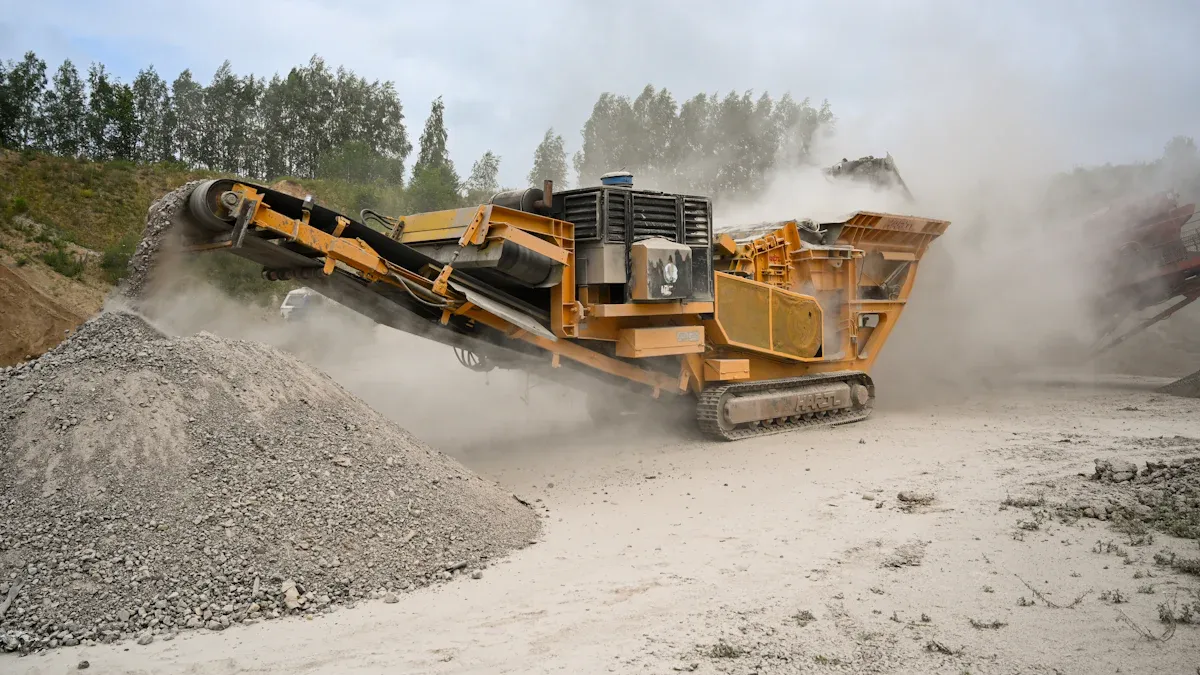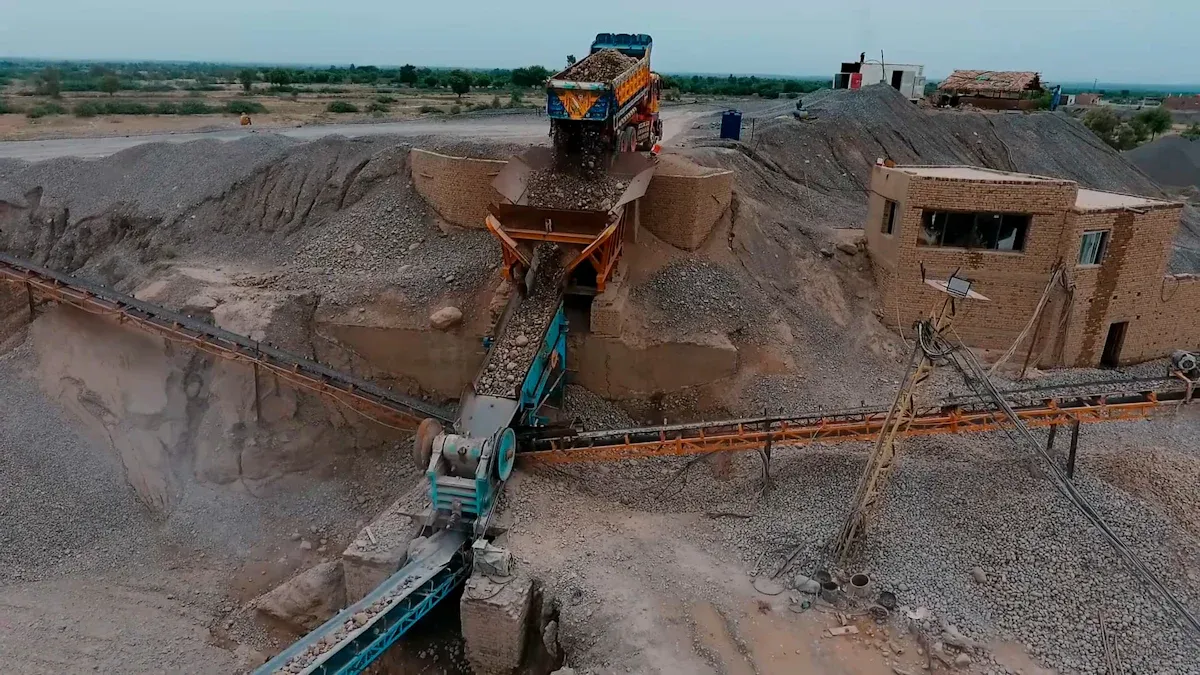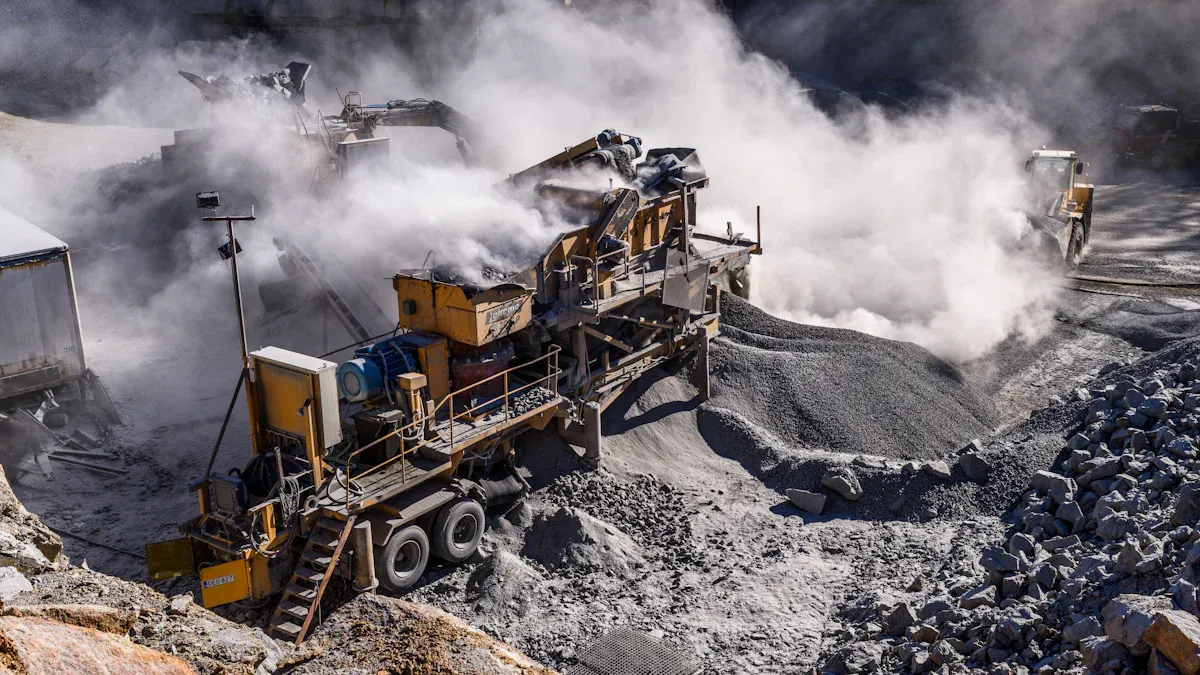
You rely on crusher wear parts to keep your crushing equipment running smoothly. These components are essential for maintaining efficiency, safety, and durability in demanding applications. High-quality wear parts reduce downtime and enhance productivity, which directly impacts your success.
In 2023, the global market for these parts was valued at millions of dollars and is expected to grow significantly by 2030. This growth reflects their critical role in industries like mining and construction. Durable wear parts are especially vital in rapidly industrializing regions such as Asia-Pacific, where demand continues to rise.

Crusher wear parts are the replaceable components of crushing equipment that come into direct contact with the material being processed. These parts endure constant wear and tear due to the abrasive nature of rocks and minerals. They are designed to protect the crusher from damage and ensure it operates efficiently. Without these parts, your equipment would wear out quickly, leading to frequent breakdowns and costly repairs.
You’ll find crusher wear parts in various types of crushing equipment, including jaw crushers, cone crushers, and impact crushers. Each type of crusher uses specific wear parts tailored to its design and function. For example, jaw crushers rely on jaw plates, while cone crushers use mantles and concaves. These parts are made from durable materials like manganese steel or alloy steel to withstand the harsh conditions of crushing operations.
Crusher wear parts consist of several key components, each playing a vital role in the crushing process. Here are the main components you should know:
Jaw Plates: Found in jaw crushers, these plates crush materials by applying pressure. They are typically made from manganese steel for durability.
Mantles and Concaves: These are used in cone crushers. The mantle rotates inside the concave to crush materials into smaller pieces.
Blow Bars: Found in impact crushers, blow bars strike the material with force to break it down.
Liners: These protect the crusher’s internal surfaces from wear and extend its lifespan.
Cheek Plates: These are additional protective plates found in jaw crushers, preventing damage to the crusher frame.
Each component is designed to handle specific types of wear, such as impact, abrasion, or compression. Choosing the right components for your crusher ensures optimal performance and reduces the risk of unexpected failures.
Crusher wear parts play a crucial role in the crushing process. They absorb the impact and abrasion caused by the material being processed, protecting the crusher’s main structure. By doing so, they ensure the equipment operates smoothly and efficiently.
The effectiveness of crusher wear parts depends on several factors, including the properties of the material being crushed and the design of the machine. For instance, rocks with high crushing strength and impact value cause more wear on the parts. Similarly, the motion of the crusher—whether it involves direct blows or abrasive rubbing—affects the wear rate.
Here’s a table summarizing key findings about the factors influencing crusher wear parts:
| Key Findings | Description |
|---|---|
| Rock Properties Influence Wear | The abrasive value of rock is best indicated by crushing-strength and impact-value, affecting wear on crusher parts. |
| Machine Design Impact | The design of the machine significantly influences wear, depending on whether the motion is a direct blow or abrasive rubbing. |
| Material Hardness Requirement | Tough materials are needed to grind hard rocks, while harder materials are required for softer rocks, indicating the need for specific wear part materials. |
| Shape of Chippings | The natural planes of weakness in rocks influence the shape of chippings produced during crushing. |
| Influence of Sharp Edges | The study examined the effect of sharp edges on abrasion, revealing no definitive relationship in the cases studied. |
Understanding these factors helps you select the right crusher wear parts for your equipment. By choosing parts that match your specific needs, you can improve efficiency, reduce downtime, and extend the lifespan of your crusher.
High-quality crusher wear parts significantly improve the performance and efficiency of your crushing equipment. These parts are designed to handle the toughest materials, ensuring smooth operations and consistent output. When you invest in premium wear parts, you reduce the risk of equipment malfunctions and achieve better results.
The installation of Metso HP3 cone crushers, for example, led to a 20% increase in throughput capacity compared to older models.
These crushers also produced a more precise product with one-pass production, enhancing overall product quality.
The improved efficiency of the HP3 is due to its advanced design, which applies more crushing force and increases aggregate concentration.
By choosing high-quality wear parts, you can maximize your equipment's potential and maintain a competitive edge in your industry.
Using high-quality crusher wear parts reduces maintenance costs and minimizes downtime. These parts last longer and require fewer replacements, which saves you money in the long run.
Lower maintenance costs lead to higher profit margins.
Regular maintenance with durable parts extends the lifespan of your equipment, maximizing your return on investment (ROI).
Well-maintained equipment operates more efficiently, reducing downtime and boosting productivity.
For example, premium wear parts can last two to four times longer than poor-quality alternatives. This extended lifespan means fewer production stoppages and change-outs, ultimately lowering your overall maintenance expenses.
Investing in premium wear parts enhances safety and reliability in your operations. High-quality parts are built to withstand extreme conditions, reducing the likelihood of equipment failures that could endanger workers.
A mid-sized mining company significantly reduced equipment failures and increased machinery lifespan after switching to premium aftermarket parts and predictive maintenance.
A large construction company experienced fewer repair costs and higher operational output by using durable parts from a reputable supplier.
Research shows that businesses using premium replacement parts experience up to 30% less downtime compared to those relying on cheaper alternatives.
Additionally, better materials in wear parts can extend their lifespan by up to 30%, according to the Mining Equipment Association. This reliability ensures a safer work environment and more consistent operations.

Using poor-quality crusher wear parts can lead to frequent equipment failures and unplanned downtime. These parts often lack the durability needed to handle the abrasive nature of crushing operations. As a result, they wear out faster and fail prematurely.
Inferior wear parts can cause unexpected breakdowns, disrupting your operations.
Generic parts, operating at only 95% efficiency of original parts, often have a lifespan that is just 80% of OEM components.
This reduced lifespan increases the frequency of replacements, leading to higher maintenance costs and lost productivity.
Proper maintenance and high-quality parts are essential for minimizing downtime. Investing in durable materials ensures your equipment runs efficiently and avoids costly disruptions.
Low-quality wear parts may seem cost-effective initially, but they result in higher expenses over time. Frequent replacements increase operational costs and reduce your return on investment.
| Aspect | Before Replacement | After Replacement | Economic Impact |
|---|---|---|---|
| Ore broken by fixed jaw plate | 750,000 t | 420,000 t | Direct loss of 160,000 yuan/year |
| Service life of fixed jaw plate | 150 days | 63 days | Increased cost per unit output by 40% |
| Ore broken by movable jaw plate | 970,000 t | 870,000 t | Increased production costs |
Frequent replacements also make it harder to manage wear rates, leading to unpredictable expenses. By choosing high-quality parts, you can reduce these costs and improve your equipment's efficiency.
Poor-quality wear parts compromise safety and shorten equipment lifespan. These parts are more likely to fail under stress, creating hazardous conditions for workers.
Equipment failures caused by inferior parts can lead to accidents and injuries.
Substandard materials increase wear on other components, reducing the overall lifespan of your crusher.
High-quality parts, built to withstand extreme conditions, enhance safety and reliability in your operations.
By investing in premium crusher wear parts, you protect your workers and extend the life of your equipment. This approach ensures a safer and more productive work environment.
Selecting the right crusher wear parts starts with understanding your equipment's unique requirements. Each crusher operates under specific conditions, and identifying these factors ensures optimal performance.
Operational Conditions: Analyze the type of material you process, its hardness, and feed size.
Crushing Goals: Define your desired output, such as product size or shape.
Crusher Parameters: Evaluate settings like closed side settings (CSS), speed, and stroke.
For example, jaw plates in jaw crushers handle primary crushing, while mantles and concaves in cone crushers form the crushing chamber. The table below highlights key wear parts and their functions:
| Wear Part | Function | Material | Replacement Frequency |
|---|---|---|---|
| Jaw Plates | Crush materials in jaw crushers. | Manganese steel | High |
| Blow Bars | Strike materials in impact crushers. | High-chromium steel | High |
| Concave and Mantle | Form the crushing chamber in cone crushers. | High manganese steel | Moderate |
Understanding these details helps you choose parts that align with your crusher's needs.
The quality and compatibility of wear parts directly affect your crusher's efficiency and lifespan. High-quality materials withstand wear and tear, reducing the need for frequent replacements.
Request certifications like ISO 9001 or ASTM standards to ensure compliance with industry specifications.
Inquire about the manufacturer’s quality control processes to verify reliability.
Consider the type of wear your crusher faces, such as abrasive or impact wear, and s elect materials accordingly.
For instance, cast iron offers excellent abrasion resistance, while composite materials provide durability under high-energy impacts. Testing methodologies like ASTM G 65-91 help rank materials based on wear resistance, ensuring you select the best option for your operations.
Partnering with a trustworthy supplie r ensures you receive durable and efficient wear parts. Reliable manufacturers prioritize quality and customer satisfaction.
Research the supplier’s reputation and customer reviews.
Verify that products meet industry standards and certifications.
Assess the supplier’s manufacturing techniques and quality control measures.
Additionally, consider the total cost of ownership. High-quality parts may have a higher upfront cost but save money in the long run by reducing downtime and replacement frequency. A reputable supplier delivers consistent quality and timely service, ensuring your operations run smoothly.
Regular inspections and maintenance are essential for keeping your crusher wear parts in top condition. By identifying issues early, you can prevent costly failures and downtime.
Perform daily visual inspections of key wear parts like rotors, liners, and jaw plates. Look for cracks, uneven wear, or other signs of damage.
Benchmark your machine's performance by keeping a log of key data, such as throughput and energy consumption. This helps you spot trends and address potential problems before they escalate.
Tip: Schedule preventive maintenance checks weekly or monthly, depending on your equipment's workload. Consistent care extends the lifespan of your wear parts and ensures reliable performance.
Installing and using crusher wear parts correctly is just as important as maintaining them. Improper installation can lead to uneven wear, reduced efficiency, and even equipment failure.
Follow the manufacturer’s guidelines for installation. Ensure all components fit securely and align properly.
Train your operators to use the equipment as intended. Overloading the crusher or using it for unsuitable materials can accelerate wear and tear.
Use the right tools during installation to avoid damaging the parts. For example, torque wrenches ensure bolts are tightened to the correct specifications.
Note: Proper usage not only protects your wear parts but also improves the overall efficiency of your crushing operations.
Monitoring wear patterns helps you determine when to replace parts before they fail. This proactive approach minimizes downtime and keeps your equipment running smoothly.
Inspect wear parts for uneven patterns, which may indicate misalignment or improper usage.
Use wear indicators, if available, to track the remaining lifespan of your parts.
Repla ce parts promptly when they reach their wear limits. Delaying replacements can damage other components and increase repair costs.
Reminder: Keep spare parts on hand to avoid delays during replacements. A well-stocked inventory ensures your operations stay on schedule.
By following these best practices, you can maximize the lifespan of your crusher wear parts and maintain efficient, safe operations.
Crusher wear parts are essential for the success of your crushing operations. High-quality parts extend the service life of your equipment, reduce maintenance needs, and minimize downtime. These benefits translate into optimized performance and cost savings. For example, advanced designs improve crusher chamber efficiency, ensuring maximum output with minimal interruptions.
To achieve the best results, you should prioritize regular inspections and informed decisions about replacements. Monitoring wear patterns helps you avoid unnecessary downtime and ensures safety for your team. By selecting durable materials and following best practices, you can maximize the lifespan of your equipment and maintain operational reliability.
Tip: Partner with trusted suppliers to access premium wear parts that meet your specific needs. This investment ensures long-term success and a safer work environment.
Look for uneven wear, cracks, or reduced performance. If your crusher produces inconsistent output or requires more energy, it’s time to inspect the wear parts. Regular checks help you avoid unexpected failures.
Tip: Keep a maintenance log to track wear patterns and identify replacement needs early.
Inspect wear parts daily for visible damage. Schedule detailed inspections weekly or monthly based on your equipment’s workload. Regular checks ensure optimal performance and prevent costly breakdowns.
Reminder: Consistent inspections extend the lifespan of your crusher and reduce downtime.
Generic parts may fit, but they often lack durability and compatibility. Using them can lead to frequent replacements, higher costs, and reduced efficiency. Always choose parts designed for your specific crusher model.
Note: OEM or high-quality aftermarket parts ensure better performance and reliability.
Select materials based on the type of wear your crusher faces. For abrasive wear, choose manganese steel. For impact wear, high-chromium steel works best. Consult your supplier for recommendations tailored to your operations.
Emoji Tip: 🛠️ Match material to your crusher’s workload for maximum efficiency.
Improper installation causes uneven wear, reduced efficiency, and potential equipment damage. Follow the manufacturer’s guidelines and use the correct tools to ensure a secure fit.
Pro Tip: Train your team on proper installation techniques to avoid costly mistakes.